
by Lisa | Mar 14, 2022 | Animation Video, Business, Technology
You’ve dialed in your script, storyboarding and even animation. Now all that’s left is making decisions regarding the audio components to drive your message home. We say “all” like it’s a small thing, but audio is make or break when it comes to your animated video. It sets the tone, shapes expectations, and aligns your brand with certain markets and audiences. Here’s what to think about when choosing your voiceover talent and music.
Music is key for evoking a certain mood in your audience. The type of music that’s ideal for your animated video will depend on the purpose and tone of your video – and also your overall brand. But in general:
- Informative video: use a light instrumental track with a slower, quieter beat.
- Advertising video: use an upbeat and motivating instrumental track or pop song (although beware of licensing fees)
Consider your audience when choosing your background and foreground music selections. Think about the demographics of your audience and their interests. Also be aware of how your music selection will work with or against your voiceover or animation – you generally don’t want anything too loud, disruptive, or distracting that takes away from your message rather than enhancing it. Typically, we recommend avoiding music with vocals, a driving beat, or prominent instrumental solos.
One thing to take note of is the cost of licensing well-known songs. These can be extremely expensive and may require you to pay royalties. Unless your budget allows for it, consider the many low-cost and royalty-free music options available instead.
Voiceover refers to the off-camera voice that explains what’s happening in your animated video. Your choice of voiceover artist is critical to the overall experience of your video, helping to convey tone, expertise, brand alignment and audience alignment.
A great voiceover is clear, well-paced, engaging, and natural, and aims to evoke a particular feeling in an audience. It’s a form of acting, and there’s a real skill to getting it right. Often, we recommend professional voiceover because they are great in cases where:
- You need someone who reflects the gender or background of your audience.
- You need an authoritative tone and delivery.
- You need to create a certain complex emotion in your audience.
- You lack the professional tools and setting to create a high-quality voiceover.
While it’s tempting to take on the voiceover role yourself or to assign it to someone on your team, this isn’t always the best choice. However, in some cases DIY voiceover can work well. Examples include:
- If you are the known face of your brand or organization.
- If you want to create a welcoming, intimate experience.
If you do choose to do your own voiceover, read slowly and clearly, with appropriate tone variation, and ensure that you use a professional recording set-up.
See in Colors has worked with a variety of voiceover talent, and we’re happy to point you in the direction of an experienced professional to help you achieve the outcome you’re seeking for your animated video. You can listen to this sample of a voice-over, and if you need help finding the perfect voice-over artist for your animation project, contact us.
So whether you’re knee-deep in animation video production or just starting to plan your project and need help putting all the pieces together, talk to us! We can ensure that your choices help create the mood and brand alignment you’re looking for. Request free quote here.
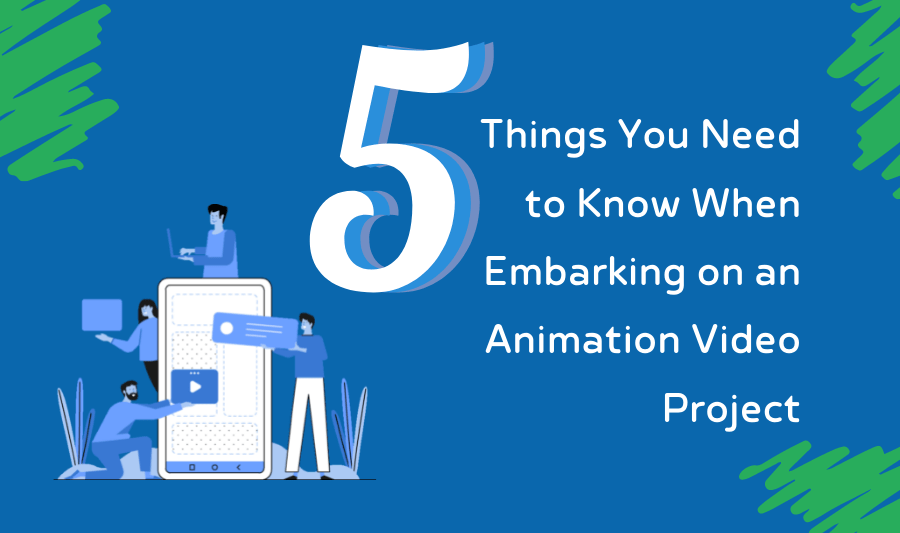
by Lisa | Feb 5, 2022 | Animation Video, Business, Leadership, Technology, Visual Thinking
Animation video is a powerful way to share information, tell stories, and boost learning. Whether your goal is to explain a product or service, or to make information stick for training and development, video elevates your communication by making it possible to break down complex ideas and processes while driving engagement and focus.
But video can also be expensive and time-consuming – with a steep learning curve. Before you embark upon your first video project, here’s what you should know.
Ever cringe your way through a bad movie? The fault probably isn’t with the acting or the special effects. No amount of flashy camerawork or fancy editing can make a great script shine. Perfect your script before you start animation and you’ll save yourself a world of pain (and money). Know who your target audience is, what you’re trying to communicate, and what your call to action (CTA) is. Your CTA creates conversions, so make sure it’s tight, clear and actionable. And don’t forget to keep your script on point: about 90 seconds (220 spoken words) is the sweet spot.
Storyboarding is a way to visually outline the information you’ll be presenting. Use it to create a timeline, identify key scenes and speakers, decide what detail needs to be added to each scene, and figure out your transitions. This is a huge but necessary step – so don’t skip it! Storyboarding will help you hone in on your budget, actors, style, and timeframe. At See In Colors we often consult with clients at this stage to make sure that they’re making powerful use of their visual medium – and that their story is being clearly and effectively communicated.
Music, sound effects, and voiceover delivery are the key things to think about when it comes to your video’s audio. Music sets the tone for your video and fosters certain emotions and experiences in your audience, from the uplifting to the serious to the motivational. Stock music can be affordably sourced through royalty-free databases, but costs add up quickly if you want to license a well-known song. Another thing to think about is who will do your voiceover – someone in-house or a professional? Your choice will influence the mood, style and reception of your video. If you decide to opt for a professional, See In Colors can point you to a great portfolio of proven voiceover artists to convey the tone you desire.
Today, many corporate videos lean heavily on animation. Motion graphics (animated illustrated footage), closed captions or dynamic sketch notes are all powerful options depending on what you’re trying to communicate. Motion graphics are visual aids that are great for breaking down facts and data – such as when explaining stats, processes or procedures. In contrast, whiteboard animation can help get a point across while also telling a story. See In Colors can help you decide which is right for your video, and walk you through stylistic options that will resonate with your branding.
The more work you put in up front, the less reworking you’ll have to do later. If you’re new to video projects, talk to the team at See In Colors to make sure you’re checking every box on the video project to-do list. Making the right strategic decisions early on will reduce time and resources spent editing, rewriting, and redesigning your video.
Ready to press play on a video project? Talk to See In Colors to ensure your project moves forward seamlessly – and with the impact it deserves.

by Lisa | May 11, 2021 | Event Planning, Facilitation, Leadership, Tech Hosting, Technology
Know the correct terms for virtual meetings to keep your virtual meetings and workshops current with the changing times. It’s important to understand these virtual meeting terms before planning and hosting your next virtual meeting or workshop.

Are you keeping up with the ever changing virtual event workspace?
How up-to-date is your virtual vocabulary?
If you host or attend virtual events, understanding the meaning of specific terms will improve the value-add that you and participants experience from virtual meetings and workshops.
Types of Virtual Events
Virtual events are online gatherings (formal or non-formal) in a virtual environment. Virtual events are used to deliver an entirely online experience for participants that are not physically together. Learn the terms for the various types of virtual meetings, such as hybrid meetings, so that you know what meeting type will best suit your participants.
- Virtual Meetings: Virtual meetings are meetings hosted online. They are hosted on online meeting platforms like Zoom and Meet or in a custom virtual world.
- Video Conference: Video conferences are much like in-person conferences, except they are online. They are built around a live agenda with sessions, breakout, and keynotes.
- Teleconferencing: An online meeting that uses telecom services like phone services and instant messaging. Teleconferencing allows participants to discuss a project, share documents, and ask/answer questions in real-time.
- Webinar: A transmission of a presentation (audio only or audio-visual), either live or pre-recorded. Webinars can access multiple viewers/listeners at the same time. Webinars usually have a level of audience interaction using Q/A, chat, and polling.
- Webcast: Like a webinar, a webcast is also a transmission of a presentation. However, no level of audience engagement is allowed.
- Hybrid Meeting/Event: Hybrid event is a combination of both a physical and virtual gathering. It is a physical gathering of people with a virtual event running for people that are not present.
- Virtual Trade Show: Virtual trade shows replicate a physical trade show. Participants can watch live/on-demand presentations from different vendors and contact them through web chats.
Virtual Meeting Glossary Terms
When it comes to planning and hosting virtual meetings and events, knowing these virtual meeting glossary terms is key in your event’s success.
Virtual Event Technical Terms
- Bandwidth: It is a measurement of how much data is delivered for an internet connection over time. Bandwidth is measured in bits and bytes or megabits per second (Mbps). The higher your bandwidth, the better your video and audio quality.
- Green Screen: A green screen is a background used to create virtual sets. With a green screen, you can replace your background with any virtual backdrop of your choice.
- Green Screen Studio: Green screen studios are filming locations with engineers that specialized in adding graphics into your videos. These studios can help you stimulate virtual background during your virtual event.
- Cloud Recording: Cloud recording lets you record and store a large volume of data without physical restraint. Cloud storage is expandable, and your data is well-protected.
- Live Streams: Live meetings/events are real-time meetings or events that can’t be replayed after the event is over.
- On-Demand: On-demand sessions are recorded and can be accessed/replayed by a listener.
Virtual Audience Terms
During your virtual event or workshop, there are various ways to interact with your audience to increase engagement and improve participant experience. Try one of these audience engagement techniques at your next virtual event.
- Breakout Rooms: Breakout rooms are smaller shared rooms that a group of attendees can meet separately.
- Q/A: Q/A (Question and Answer) lets your audience leave questions for the presenters. The audience can use the chat for Q/A. However, it can also be a separate tool.
- Polling: Polling gathers information through real-time input from the participants in a virtual event. Often, the audience’s opinions are recorded through a series of multiple questions.
- Polling Module: A polling module displays the information gathered from polling.
- Chats: Chats are used to send messages in real-time to participants or organizers during virtual events. The audience can use chats for Q/A or to start a dialogue and engage.
Know the correct terms for virtual meetings to keep your virtual meetings and workshops current with the changing times. It’s important to understand these virtual meeting terms before planning and hosting your next virtual meeting or workshop.
Do you need help with designing or hosting your next virtual event? Reach out to us to learn more about our Meeting Design & Facilitation services.
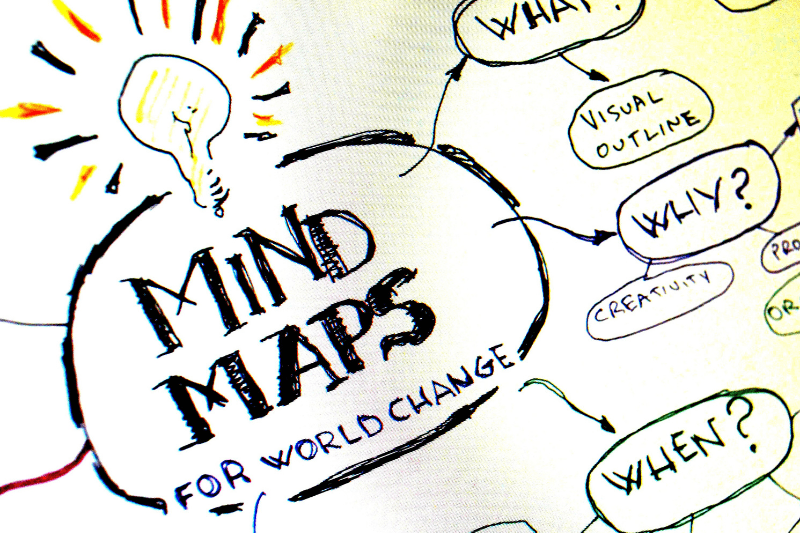
by Lisa | Mar 2, 2021 | Business, Facilitation, Technology, Visual Thinking
Project planning is a crucial phase of your project. You can’t afford to skip it. Visualization techniques can help you get on the right track. Learn if you are using the right tools and techniques to get the desired results.
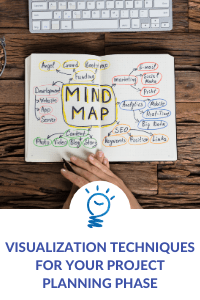
The planning phase is arguably the most crucial stage of a project’s life cycle. At this stage, you determine the logistics, budget, and other important details.
Here you can define and discuss potential problems your project might face at the different stages of execution. Then you can brainstorm with your team and provide possible solutions to these problems.
More importantly, it is during this project planning phase that you need to identify and select the RIGHT problem that your project will solve upon successful execution.
Why?
Identifying and presenting the key problem your project will solve to stakeholders is vital for effective communication and ensuring expectations are met.
So, how can you create an invaluable project management plan and identify the correct problem?
There are several visual planning tools and project plan visualization techniques that can help you execute this crucial part of the project planning phase.
Why Should You Use Visual Planning Tools and Techniques?
Turn a project’s large volume of data into useful and straightforward diagrams that help you brainstorm and communicate the project’s SWOT (strengths, weaknesses, opportunities, threats).
Outline and visualize all stages of your project’s life cycle so you can present a high-level plan to project stakeholders.
Better yet, you can use visual planning tools at all stages of your project execution!
It’s true, visual planning techniques help foster creativity when approaching and solving complex situations or problems. Visual techniques like mind mapping, process maps, or cost breakdown structures are crucial to your project planning.
Types of Visualization Tools for Project and Program Planning
There are many project planning tools and techniques to use for project management, but not all are suitable for the planning phase. Your visual planning phase should be a detailed process where you might use several project planning techniques and tools.
Here are the top visual planning techniques that will help ensure that you identify the key problem, that your project’s stakeholders and team are on the same page and that expectations are clear and met.
1. The Six Thinking Hats:
This can be done remotely or at in-person meetings to explore different viewpoints related to complex situations or problems. Team members will wear different “hats” that represent different thinking perspectives. The six thinking hats are: Creativity, Process, Benefits, Facts, Cautions and Feelings. Use an online whiteboard tool to take notes on each of the participants points of view.
2. Starbursting:
Help meeting participants fully understand the problem that your project is going to solve. Once a team identifies a problem, draw a 5-point star and label each of the 5 points: What?, Where?, When?, How?, and Why? Have meeting participants collaborate and add detailed questions to each of the 5 categories.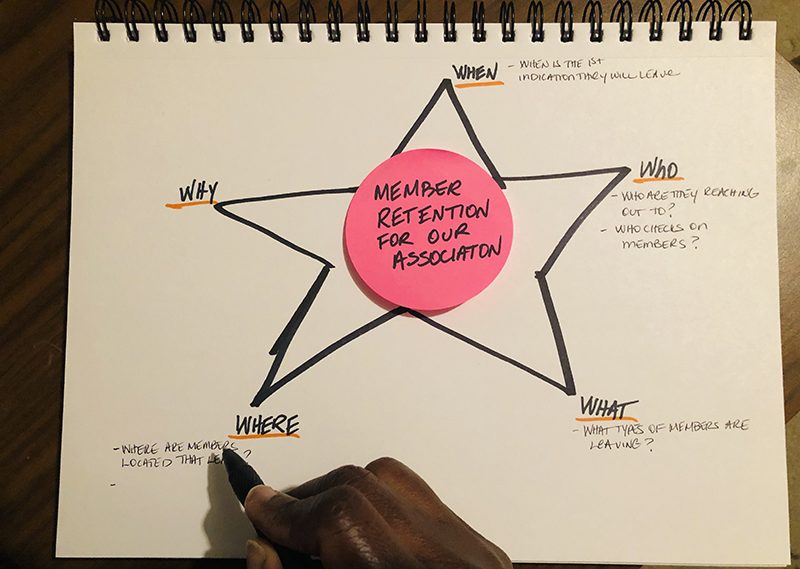
3. The Five Whys:
More specifically used for quality improvement, and to thoroughly analyze a problem, repeatedly ask the question, “Why?”. Using a whiteboard, state the problem. Then list out five boxes below the problem statement, each with the question of why? As you repeatedly answer why, you will eventually reach the root cause of a problem.
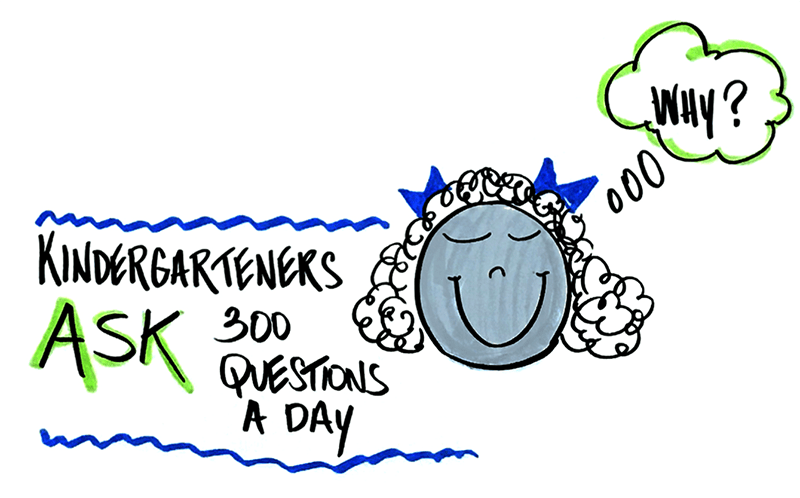
4. Mind Maps:
Mind mapping is a useful way to gather and organize all information about your project. Mind maps are crucial to the information-gathering process. Mind maps can be helpful during brainstorming sessions to generate and gather new ideas. Besides, you don’t have to collect information hierarchically. You can add ideas as they come to mind, and the mind map will help you present the information in an orderly and meaningful way.
Project Management Apps For Visual Project Planning
Project management software helps you collaborate effectively with your team and carry out your visual planning. Most apps are designed to work for remote meetings as well. So, your team members and project stakeholders don’t have to be physically present to brainstorm on your project.
There are various project management applications that help to effectively assign tasks, manage, and track your team’s progress such as Trello, Asana, and TeamGantt. But what about apps for visual project planning?
Think collaborative whiteboard apps, such as Mural, Miro, Zenkit, Google Jamboard and Lucidchart.
Collaborative whiteboard project management apps provide the option to collaborate visually in real-time, and allow meeting participants to add sketches, notes, videos and more to a digital canvas.
Conclusion
Project planning is a crucial phase of your project. You can’t afford to skip it. Visualization techniques can help you get on the right track. But you must be sure you are using the right tools and techniques to get the desired results.
Do you need help facilitating your meeting so that everyone can see the big picture? You can reach out to us here to help you out with visual planning.

by Lisa | Dec 18, 2020 | Entrepreneur, Facilitation, Productivity, Technology, Visual Thinking
In 2020, working remotely became the norm rather than the exception. Many companies plan to continue with their work-from-home arrangement into 2021. What does this mean for you? Virtual meetings are here to stay, so it’s time to set up your home office with productivity tools to stay on target with your 2021 goals and ensure your virtual meetings run smoothly. Here are my top tools of 2020 to help you stay up to date on the latest and greatest work-from-home gadgets.

In 2020, we saw a sudden increase in the use of video conferencing. Mainly due to the pandemic restrictions.
Online meetings replaced face-to-face meetings and video conferencing became a regular means of collaboration.
In fact, working remotely is now the norm rather than the exception.
Although restrictions vary based on region, many companies prefer to continue with their work-from-home arrangement. Just recently, Google and Facebook announced that they will continue with their remote work arrangement for now.
What does this mean for you? Virtual meetings are here to stay! It is important to set up your home office with productivity tools to stay on target with your 2021 goals, and video conferencing equipment to ensure your virtual meetings run smoothly.
To help you stay up to date on the latest and greatest work-from-home gadgets, here are my top tools of 2020 that I keep in my teleworking toolbox.
1. Microphone/Headsets
The last thing you want during your video conference is terrible audio!
People should hear you clearly during your virtual meetings and using only your computer’s microphone may provide a poor audio experience.
Adding a superior external microphone or headset to your virtual meeting toolbox will ensure your audience can hear you properly during virtual meetings.
There are several microphone brands on the market to give you crisp, clear audio. Do consider if you are uncomfortable sitting in front of a microphone, and if so, go for a headset instead.
While a wired headset is a great choice, the wiring and cabling creates limitations.
You can go for the Bluetooth models that offer comparable audio quality; however, they are a bit more expensive.
Lastly, if your work-from-home environment is loud, minimize distractions by opting for a noise-cancelling headset.
Personally, I prefer a microphone, and recommend the SNOWBALL Microphone.
2. Document Cameras
Document cameras are a small and powerful replacement for transparency projectors, This specifically designed web camera projects crisp and clear images onto a display, a great addition for virtual meetings and presentations!
I use the IPEVO V4K Ultra High Def Document Camera. It allows me to draw and have meeting participants see me working on a sheet of paper. My version of the Ipevo is old and it doesn’t even have a light but I still love it.
However, the IPEVO VZ-X 8MP Document Camera has a light and WIFI included if you are interested in those specs.
A third option, that a colleague of mine raves about, is the INSWAN INS-1 Tiny 8MP USB Document Camera.
At the Black Maternal Mental Health Summit, we used our document camera alongside the Powerpoint presentation as a means to visually communicate with the attendees of the event.
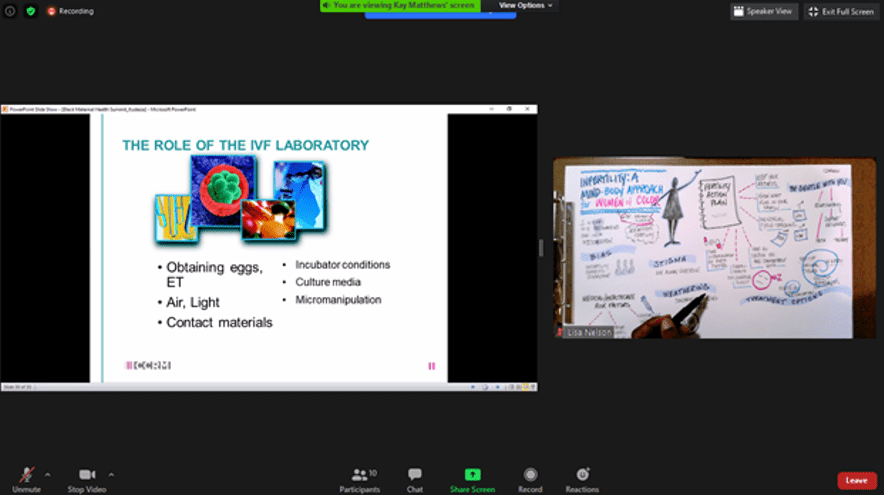
3. Lighting
Invest in good lighting!
Although natural lighting can be good enough for some video conferences, better lighting improves your video quality.
If your desk is located in a darker area of your room, there will be no need to find the right angle if you have a to brighten up your workspace!
With a proper lighting device it will be easier to video call at any time, including night.
I recommend the Neewer Ring Light Kit that comes with a tripod stand, dimmable LED lighting and color filters.
Looking for a more affordable LED Ring Light option that can hold your phone, has an adjustable color temperature range, and can clip on your desk or laptop? The UBeesize Selfie Ring Light checks all of those boxes and is compact and quite versatile!
In summary, the top three specifications to consider when purchasing your video conference lighting device are its dimmability, does it have the option to control the color temperature, and whether it provides adjustable positioning.
4. Traditional “Lo-Fi” Office Tools
Aside from the tech gadgets mentioned above, there are three key office tools that I recommend for seeing the big picture with visuals.
I love this UCreate Sketch Book, it’s always on the right-hand side of my desk, right next to my mouse where I put all of my notes. You can easily turn the sketch book from profile to landscape orientation, allowing for less restriction. There are also no lines, so you can sketch and doodle to your heart’s content!
Keep a Bullet Journal handy, specifically one that includes a dotted grid to make note-taking easy and increase productivity.
Lastly, every year I order a new wet & dry erase wall calendar which is located above my desk so that I can easily add, remove or revise events and goals. I love seeing the year at a glance, because I’m a visual person of course 🙂
Leave a comment and tell us about your favorite work-from-home tools!
Photo by Tima Miroshnichenko from Pexels

by Lisa | Dec 9, 2020 | Business, Event Planning, Facilitation, Technology
How do you plan to host your holiday office party this year? Since many employees are still working remotely, a virtual office party is a great choice. If the thought of hosting a virtual holiday party seems overwhelming, don’t worry. We have got you covered! You can still organize a fantastic holiday office party this year and say, “Cheers!” Here are some practical tips to help you plan and host your virtual office holiday party.

The Covid-19 pandemic created a lot of change in the workplace. Quarantines and lockdowns pushed most companies to pivot to virtual. Now we are in the second wave of the virus as the holiday celebrations begin.
How do you plan to celebrate your holiday company party this year?
Since many employees are still working remotely, a virtual office party is a great choice.
If the thought of hosting a holiday party on zoom seems overwhelming, don’t worry.
We have got you covered! You can still organize a fantastic holiday office party this year and say, “Cheers.”
Here are some practical tips to help you plan and host your virtual office holiday party.
Organize Ahead
Don’t make the mistake of not planning!
While virtual parties may seem more manageable than non-virtual parties, without the right planning, things can get out of hand quickly. Use a spreadsheet to plan and stay abreast of each of the activities.
There are numerous logistics involved when planning a virtual meeting, and your spreadsheet will help you organize better and stay on track.
Choose the Right Time and Date
Don’t forget about the date and time. Make sure everybody or most people will be available to attend the party.
To ensure your employees’ full attention, your holiday party should not coincide with the holiday itself. Additionally, ensure the time is convenient for team members in other time zones.
An easy way to decide is to take suggestions from your team. Ask them about a suitable time and date.
Choose the Right Platform
Pick a virtual location suitable for everybody.
At this point, your employees are familiar with virtual meetings. So there should be minimal challenges in providing instructions to your team about connecting to most of the popular video conferencing apps.
Consider the time and people limit of the platform. Zoom is a likely choice because of its flexibility.
However, your employees may be tired of Zoom by now. So, consider other virtual locations like Houseparty, Facetime, or Google Hangouts.
Whatever platform you decide on, do a test-run! And test-run some more! Be sure there won’t be any technical difficulties during your party.
Don’t Forget to Send Out Invites and Reminders.
Use your invite to get employees excited about the party!
Be creative with your invites, whether it is an e-invite or physical invite. Set a festive tone with your invite. That way, they can start looking forward to the party.
Don’t forget that your invite should contain the party’s time, date, and virtual location. And send reminders to keep your employees anticipating the event.
Pick a Theme or Do Something Out of the Ordinary
Pick a theme for your virtual party!
Think of hosting the virtual holiday party as an opportunity to do something extra-ordinary. Here are some party themes or ideas you can consider for a virtual office party.
Whatever you choose, make sure it is virtually stimulating and engaging.
Send Physical Gifts
Show your appreciation for your employees with gifts. Hosting a virtual holiday party should not stop you from sending a physical gift.
Send the holiday gifts ahead of the party to your employees. To avoid delivery problems, make sure you have the correct mailing address and send well ahead of the event date to ensure sufficient time in transit, taking into consideration the holiday shipping delays.
Play Games and Provide Entertainment.
Just like other parties, provide entertainment and games!
Games will keep people engaged in the party. You can even provide gifts to the winners of the competitions and games. Here are some office party game ideas you can choose from.
Take your entertainment a step further. Book entertainers like musicians, magicians, comedians for a remote show. Doing this will make your virtual party experience more worthwhile for your employees.
You can still create the perfect virtual company holiday party experience for your team. All you need is the holiday spirit and a little planning!
CLICK HERE for a free quote for Tech Hosting for your Virtual Holiday Company Party.













